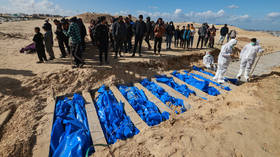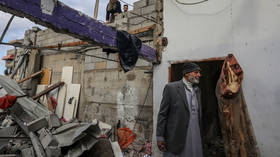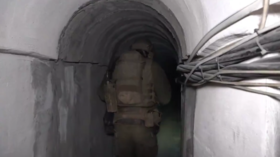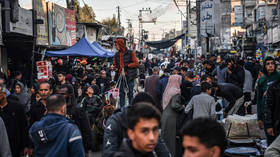Here’s why you shouldn’t trust the ‘declining’ Gaza death toll narrative

Shortly before the International Court of Justice’s highly anticipated decision to pursue South Africa’s case accusing Israel of genocide, the New York Times released a report titled ‘The Decline of Death in Gaza’.
The article attributed this alleged decline to a change in Israel’s battle strategy in Gaza, yet the piece omitted key data that contradicted its claims. Then, in the aftermath of the ICJ preliminary ruling, the NYT became the first news outlet to receive and publish information from an Israeli dossier that accused UNRWA staff of complicity in the armed activities of Hamas.
Since the beginning of the war between Israel and Gaza, which began with the Hamas-led attack on October 7, Western corporate media have shown what can only be described as pro-Israeli double standards. On January 9, The Intercept published a quantitative analysis of over 1,000 articles in US mainstream media, including by the NYT, proving the undeniable bias demonstrated in favor of Israeli life and underreporting on Palestinian suffering.
An even more targeted analysis was published by researchers Jan Lietava and Dana Najjar, who specifically looked at the BBC’s coverage of the conflict between October 17 to December 2. The study documented that words like murder(ed), massacre(d) and slaughter(ed) were used by the BBC to describe Israelis 144 times, while Palestinians had only been described as having been murdered or massacred one time each; the word slaughter had never been used to describe the killing of Palestinians. The study clearly shows the disparity in humanizing language used and the number of stories on Palestinian deaths, despite the Palestinian death toll being far higher than the Israeli one.
The Israeli death toll throughout the war officially stands around 700 civilians and 600 combatants, while for Palestinians it is roughly 27,600, according to the Gaza Health Ministry. The estimates are that between 61% to 75% of the Palestinians killed in Gaza are women and children. Ranging estimates as to how many Palestinian combatants have been killed are not trustworthy. Israeli spokespeople claim between 7,000 to 10,000 Hamas fighters, depending on the time of day, but provide no estimate for the number of fighters killed who are members of the dozen or so other armed groups in Gaza.
While the NYT report attempts to make the point that deaths in Gaza are steadily declining as the Israeli operation goes on, statistics released by the authorities in Gaza, from January 17 (when the NYT data chart ends) until January 24, clearly show the opposite trend. For reference the daily death tolls read: 163, 172, 142, 165, 178, 190, 195, 210.
The piece also lacks any evidence showing a correlation between the Israeli announcement of what it calls “phase 3” of its battle plan and the death toll charts that showed a downward arc in the daily fatality rate. Israel began announcing its intention to implement its new phase at the beginning of January, yet the argument presented in the article attempted to draw the conclusion that pressure from the US government had contributed to a lowering of fatalities between early December and January 17.
There was a decline in the daily reported death toll, but this occurred prior to any stated change in the military strategy. Also observable is that during the week that the report was released, the daily Gaza death toll actually jumped to 188. Monday through to Sunday of that week there were some 1,317 Palestinians killed by Israel. The week prior, a total of 1,110 were killed.
The NYT also pointed to the Israeli withdrawal of forces from northern Gaza, attempting to use this as evidence of a change in tactics in January that had been brought about due to efforts from the Biden administration. Israel actually reinvaded the north, briefly, after the article was published.
Furthermore, Israel didn’t start withdrawing from northern Gaza in January – it began this process around December 21, when it withdrew the elite Golani Brigades. In late December, five brigades were withdrawn and the reservists amongst them were released for economic reasons. Then, earlier last month, a further four brigades were withdrawn as the Israeli army implemented a retreat from most of the built-up areas in northern Gaza.
Israeli authorities claim that the reason for the change in the war strategy, shifting from the high-pressure tactics of the first two phases, was due to their desire to continue the fight for the whole of 2024. If Israel is planning to fight a year-long war, it makes sense for it to use fewer munitions and soldiers, as munitions are finite and the cost of the initial battle strategy would have been a significant economic burden.
Another crucial point is that the report completely left aside all other considerations as to what could explain a decline in death tolls across certain periods of time. A major issue that is faced today is a lack of a properly functioning health sector in Gaza altogether; according to the World Health Organization (WHO), only 16 hospitals out of 36 remain operational and all are “minimally or partially functioning.”
One of the last remaining professional journalists in northern Gaza, Anas al-Sharif, reported to Al Jazeera Arabic, on January 16, of the intensifying bombardments in the area and the underreporting of casualties there. A resident named Akram based in the Jabalia Refugee Camp told RT that “the bombing over those few days returned to how it was at the start of the war, it was terrifying and it seemed like it didn’t stop at all for over a day.”
With a health sector that has all but collapsed, properly accounting for the dead is a tough challenge, which is why the Gaza Health Ministry routinely includes the caveat to its daily death tolls that there are others under the rubble who are unaccounted for. To demonstrate how big of a difference the death toll is, when those missing under the rubble are factored in, take the statistics released by Euro-Med Human Rights Monitor, which stated that 31,497 Palestinians had been killed by January 14.
Aside from us not having a full picture of the true daily death toll, Israel is also being accused of using starvation as a weapon of war, and the statistics that are being cited do not include those who are now dying due to disease and starvation. Some 400,000 people living in northern Gaza are without aid altogether, as efforts by international organizations to transport medical, food and fuel aid to the north have repeatedly been blocked. On December 9, Save The Children warned that the primary cause of death in Gaza could soon be starvation and disease, instead of bombs, with the humanitarian situation having severely deteriorated since then.
When the Israeli government later released its allegations that 12 UNRWA employees – out of 13,000 working in Gaza – had participated in the Hamas-led attack of October 7, the New York Times was the first to get its hands on the Israeli dossier that detailed its allegations. The newspaper failed to report that most of the allegations were based on interrogations conducted by the Shin Bet (Israeli secret police), which is renowned for extracting confessions through torture. The article that the NYT published on the issue made the dossier’s information seem somewhat credible, yet, when the UK’s Channel 4 obtained it and quoted it directly to the public, it concluded that “no evidence” was contained within the dossier.
The NYT’s reporting on Israeli allegations that Hamas conducted a premeditated mass rape campaign have come under fire also. In one case family members of an Israeli woman killed on October 7 had to take to social media to denounce the NYT’s attempts to suggest she had been raped, which the newspaper allegedly failed to tell the family it was planning to include in its article.
At every turn, Western corporate media has used distortions, linguistic manipulation, and outright lies to mislead its audiences on the truth about what is occurring in Gaza. It does not get lower than playing with statistics in order to downplay what the highest judicial body on earth has overwhelmingly ruled is plausibly a genocide, or what UN aid chief Martin Griffiths has called “the worst ever” humanitarian crisis.
The statements, views and opinions expressed in this column are solely those of the author and do not necessarily represent those of RT.
















